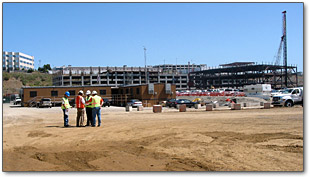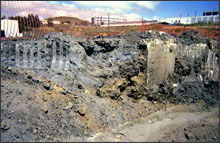Pacific Southwest, Region 9
Serving: Arizona, California, Hawaii, Nevada, Pacific Islands, Tribal Nations
Genentech Development in South San Francisco
New Colors for Old Paint Factory

Phase 1 of "Britannia East Grand" Facility is underway, to be completed in 2008.
A new biotechnology campus will rise where a decrepit century-old paint factory once stood in South San Francisco, thanks to a recent RCRA brownfields agreement. California’s Department of Toxic Substances Control (DTSC) reached a prospective purchaser agreement (PPA) with Genentech, one of the world’s leading biotech companies, to create an innovative 27-acre expansion of Genentech’s existing corporate campus. The PPA allows new construction while requiring that the known environmental contamination at the site is appropriately addressed to protect construction personnel as well as future occupants at the site.
Property Use and Cleanup History
W.P. Fuller and Company originally ran a paint and coatings manufacturing business at the site beginning in 1898. Paint manufacture resulted in extensive problems with lead in soil and in the former San Bruno Channel. The O’Brien Corporation, a paint manufacturer, purchased the site in 1967 and managed
- 784,000 square feet of new development with eight combined laboratory/office buildings, a fitness center, a childcare facility and two parking structures.
- Jobs for an additional 1,800 to 2,000 highly compensated biopharmaceutical employees, further enhancing the Bay Area’s growing biotech industry base
- Increased property and payroll tax revenues, currently estimated to be an additional $4.5 million per year
- Millions of dollars infused into the local economy in construction costs for the tenant improvements
- Substantial sales and use tax revenues
- Considerable aesthetic benefit from the clearing away of abandoned industrial buildings from a beautiful stretch of coastline

The site of the former O'Brien paint factory was industrialized since the turn of the twentieth century and was built on industrial fill.
Initially, EPA assumed supervision of corrective measures for the soils under Resource Conservation and Recovery Act (RCRA) authorities, but since 2000, DTSC has held full regulatory lead at the site. Cherokee Investment Partners purchased the site in 1999 and commenced cleanup in preparation for redevelopment. The site was subsequently purchased by Slough SSF, LLC in 2000. Cherokee will complete the RCRA corrective action for groundwater, including assessment of contamination and any necessary cleanup. Slough will conduct all needed operation and maintenance activities, provide any financial assurances, and enter into a land use covenant to restrict most portions of the site to commercial use. Slough is constructing the facilities in phases over the next four years, and has contracted with Genentech for a mult-year long-term lease with an option to purchase. Genentech is expected to begin occupancy in late 2006.

Artist's rendering of Genentech's new research campus, which will have two new parking structures and eight research and development buildings
What is a brownfield?

Corrective measures for soils were conducted in 2000. Approximately 16,000 cubic yards of soil were removed.
More Information
Ms. Wei Wei Chui (WChui@dtsc.ca.gov) of DTSC
(510) 540-3975
